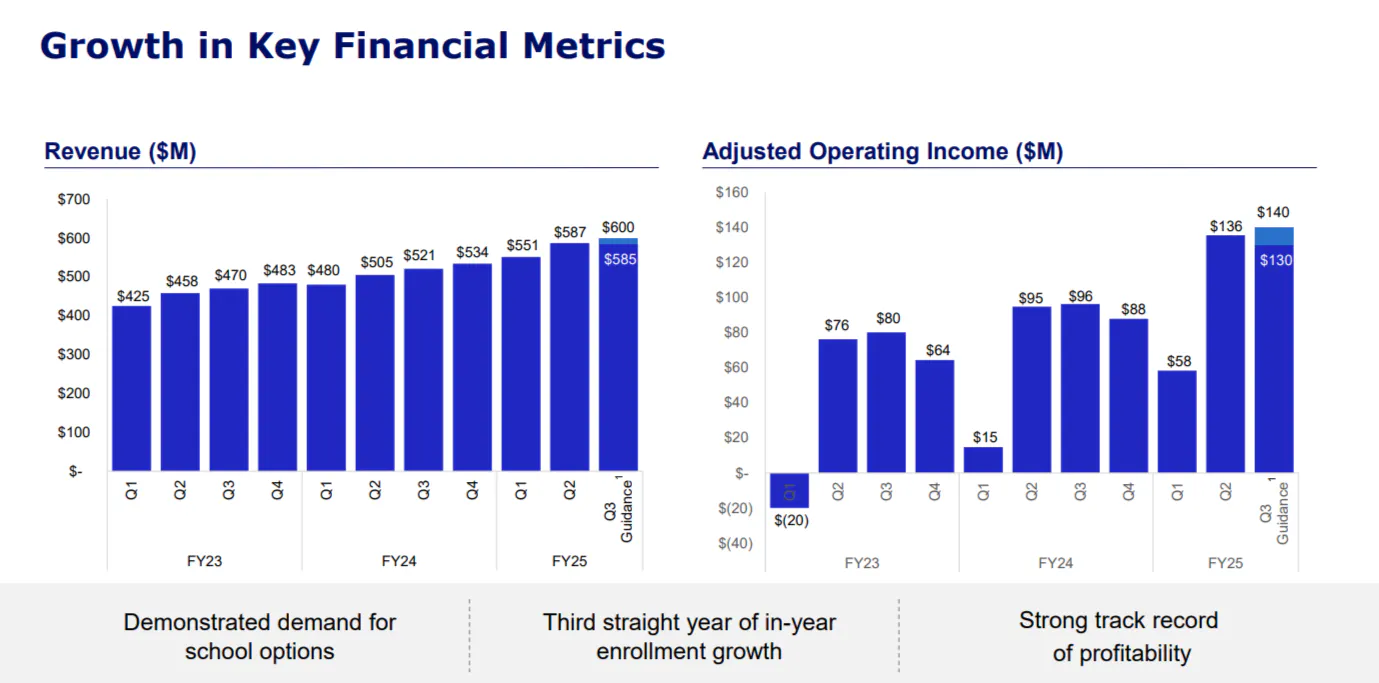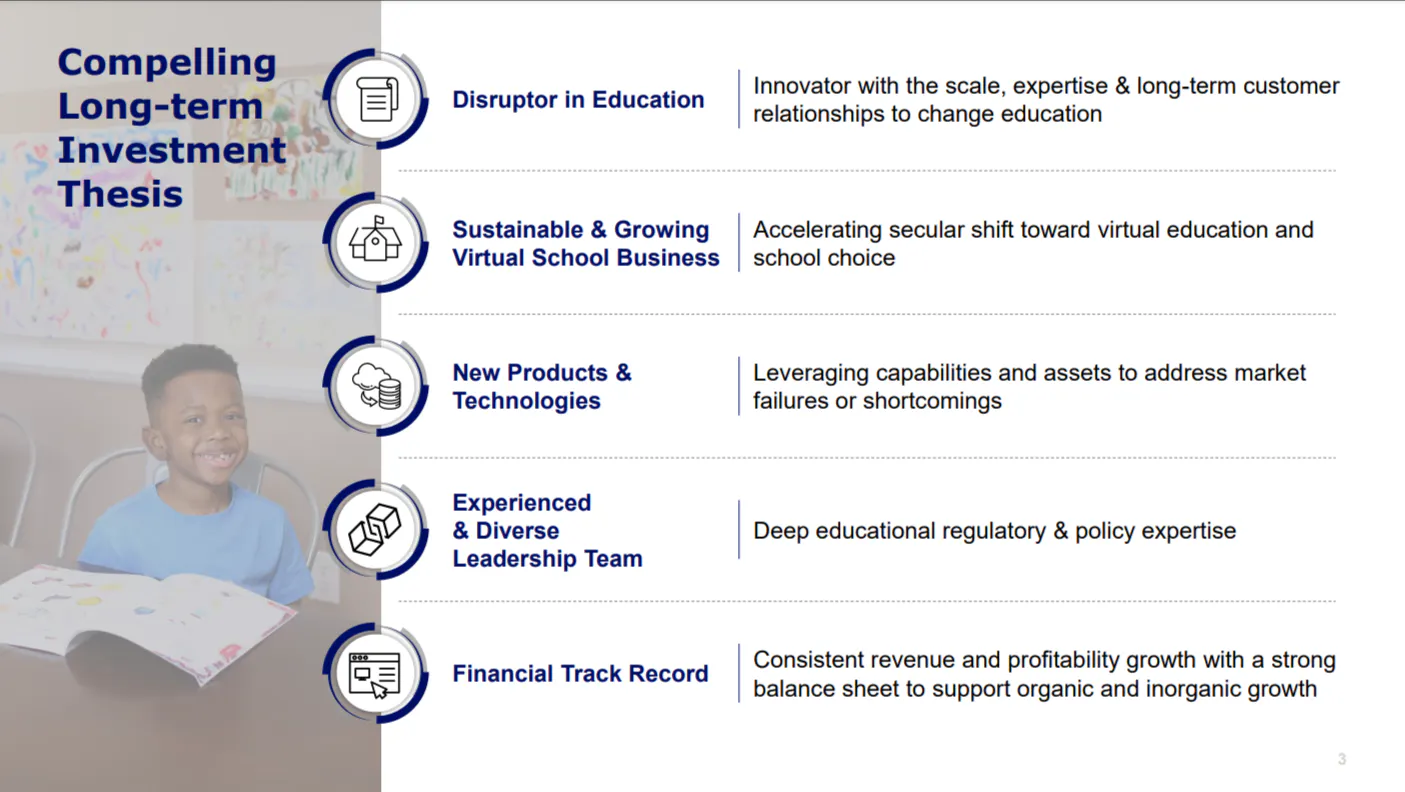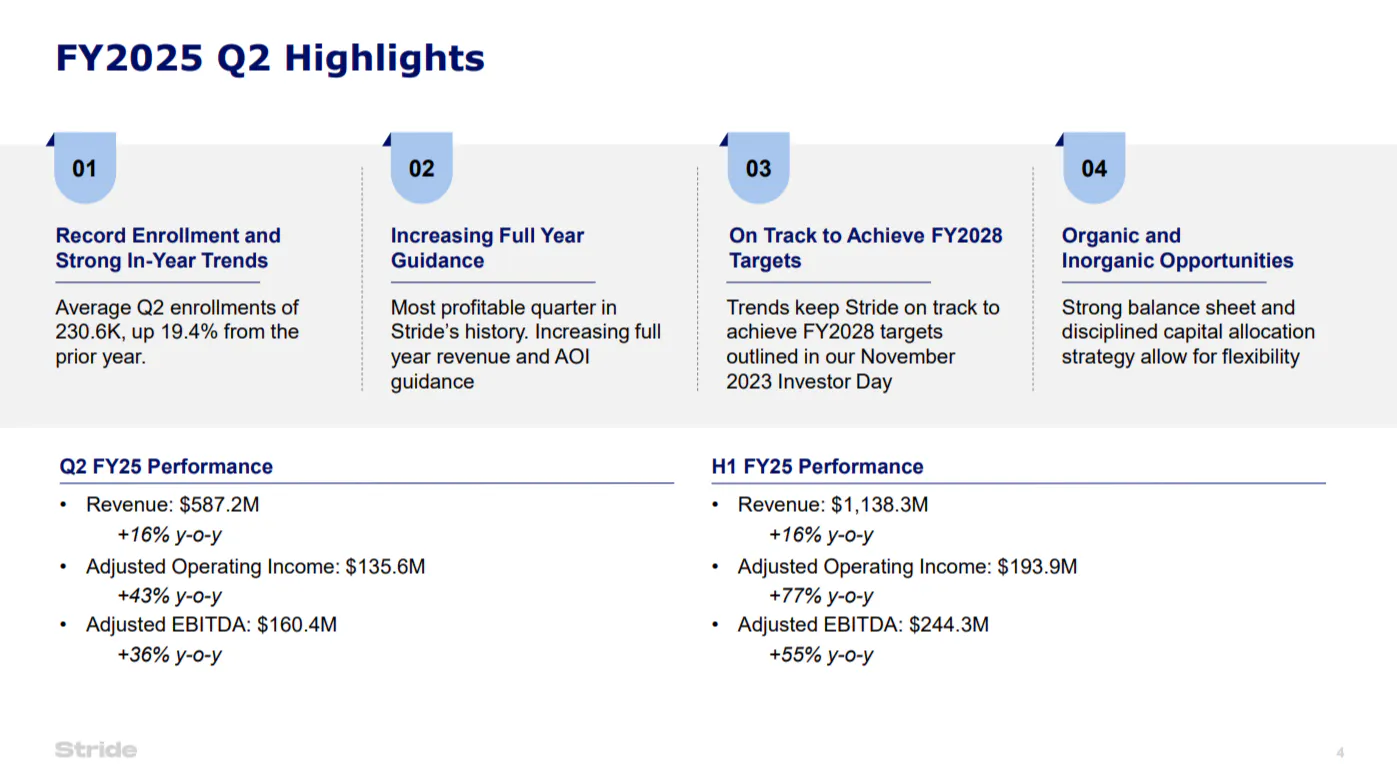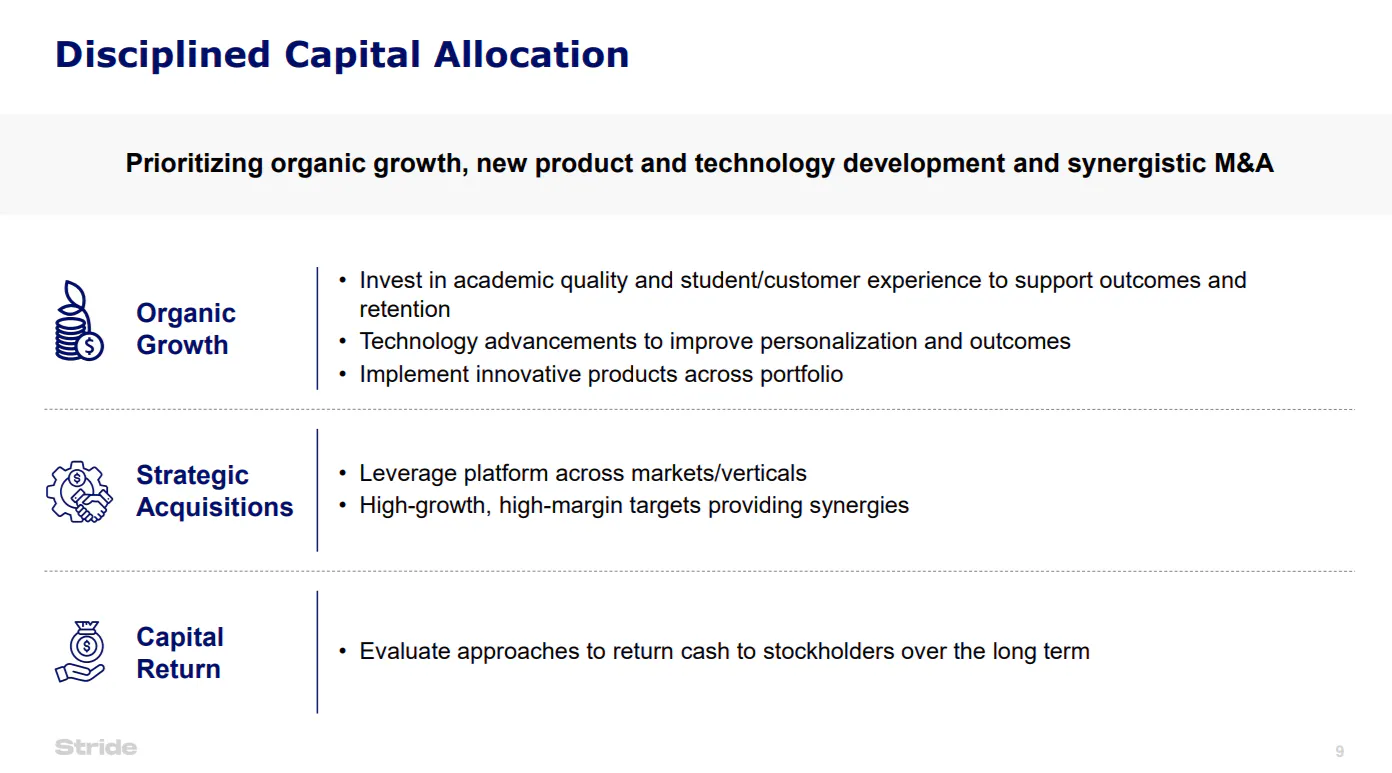Deep Stock Analysis of Stride Shares with Large SWOT-Analysis
At a time when education and digital learning opportunities are becoming increasingly important, Stride Inc. (S'ouvre dans une nouvelle fenêtre) (formerly K12 Inc.) has established itself as a major player in the market. The company offers a wide range of educational services and technologies, benefiting from long-term trends such as digitalization and the increasing need for personalized education. What future prospects does Stride offer? In this Stride analysis, we take a detailed look at the company, its business model and its growth prospects. Let’s Go!

Stride has made remarkable progress in recent months and has reported strong financial results. In the first quarter of fiscal 2025, revenue increased by 14.8% to $551 million, while operating profit improved from $3.3 million a year earlier to an impressive $47.3 million. Enrollment also grew by 18.5% to 222,600 students. Growth was particularly strong in the Career Learning segment, where enrollment increased by 30%. This success reflects the growing demand for flexible and virtual education offerings. The company was also able to allay concerns about the expiration of state ESSER funds, as the impact on revenue is estimated to be small at less than 3%. The second quarter was no less interesting. In the second quarter of fiscal 2025, Stride generated revenue of $587 million, an increase of 16.3% year-on-year. Operating income increased 48.4% to $125 million and net income grew 44% to $96 million. Diluted earnings per share increased to $2.03, while adjusted operating income reached $135.6 million and adjusted EBITDA reached $160.4 million. These strong numbers reflect the company's continued growth and increasing profitability. Let's look at Stride's company history.
Stride's company history
Stride Inc. was founded in 2000 under the name K12 Inc. and has since established itself as one of the leading providers of online education programs. The company began by providing educational content for school-age children and teens, particularly for homeschooling programs and virtual schools. Over the years, the company has evolved and now offers a wide range of educational services, including professional development and technical training.
A milestone in Stride's history was its rebranding in 2020. This move reflected the company's expanded mission to not only offer traditional educational programs, but also to integrate adult education and professional training. Today, Stride positions itself as a comprehensive provider of lifelong learning and digital education platforms.
Stride's business model
Stride's business model is based on providing educational services and technologies to various target groups. The company generates revenue by collaborating with public schools, private education providers and companies that invest in the training of their employees.
Stride offers both complete virtual school solutions and modular learning platforms that can be customized to meet individual needs. The company uses a combination of its own educational content and partnerships with external content providers to create a comprehensive and flexible learning offering.
Another important part of the business model is the provision of educational platforms for professional development and technical training. These platforms are designed to provide participants with practical skills that are in demand in the modern job market.

Detailed description of Stride's business segments
1. K-12 educational solutions
Stride's core segment remains the delivery of educational content and technology to students in grades kindergarten through 12. The company works with virtual schools that are either state-run or privately operated. The platform offers interactive learning modules, teacher support and comprehensive assessment tools.
2. Continuing vocational training and adult education
This segment has grown significantly in recent years. Stride offers online courses and training programs aimed at professional upskilling and reskilling. This includes technical training in areas such as IT, healthcare and manufacturing.
3. Technology and platform services
Stride provides educational institutions and companies with technical platforms that digitize and optimize the learning process. These include learning management systems, analysis tools and communication platforms.
Peculiarities of the market and the industry
The education industry is undergoing profound change. Digitalization has challenged traditional teaching methods and increased the need for flexible, personalized learning solutions. Online learning has established itself as an indispensable component of the education system since the COVID-19 pandemic.
Stride is benefiting from this development, as the company has been focusing on digital education offerings since its founding. According to forecasts, the e-learning market will continue to grow strongly in the coming years. Platforms that not only provide content, but can also measure and analyze learning success are particularly in demand.
Another important trend is the increasing demand for professional development. In a world characterized by technological change, employees must continuously acquire new skills. Stride is well positioned in this segment and can benefit from the growing demand for technical training.
Stride's growth opportunities and long-term trends
Stride faces several promising growth opportunities:
1. Digitalization of the education system
Increasing digitalization offers companies like Stride numerous opportunities to expand their business. More and more schools and educational institutions are relying on digital learning platforms and hybrid teaching formats. This opens up the possibility for Stride to offer customized software solutions and content that support teachers and learners alike. Digital learning platforms enable more flexible teaching, independent of fixed time and location requirements. Data-driven analysis tools for assessing learning progress play a central role. Stride could score points in this area with innovative functions to make learning even more effective and relieve the burden on teachers.
2. Growing market for professional training
In a world that is changing ever faster due to technological advances and changes in the job market, professional training is becoming increasingly important. Companies must continuously qualify their employees in order to remain competitive. Private individuals are also investing more in their professional development. Stride has recognized this potential and offers comprehensive solutions, including online courses, certification programs and customized training for companies. By combining flexible learning formats and industry-specific content, Stride is positioning itself as a reliable partner in professional qualification.
3. International Expansion
So far, Stride's focus has been mainly on the US market. However, expansion into international markets offers considerable growth potential. In many countries, there is a high demand for digital education offerings, especially in regions where access to high-quality education is limited. By entering international markets, Stride could tap into new customer groups and sustainably strengthen its market position. However, this requires that the content and platforms be adapted to the respective cultural, linguistic and educational requirements of the target markets.
4. Strategic partnerships
Strategic partnerships are key to success in the dynamic education market. By working with education providers, technology companies and industry associations, Stride can expand its offering and reach new target groups. Partnerships with universities and technical colleges could increase the reach of the platform, while cooperation with technology companies provides access to the latest developments in educational technology. Such alliances not only strengthen Stride's innovative power, but also help to improve customer loyalty.
5. Artificial Intelligence and Personalization
The use of artificial intelligence (AI) in education opens up completely new possibilities for personalized learning. Stride invests in technologies that tailor the learning process to the individual needs of the participants. Intelligent algorithms can analyze learning progress and provide targeted recommendations for further learning content. This not only increases learners' motivation, but also improves their learning success. AI-based tutoring systems could play an important role in the future by offering learners real-time assistance and relieving teachers.
Stride's latest quarterly figures Q2/2025

Stride, Inc. made significant progress in the second quarter of fiscal 2025 and presented strong financial results. Revenue increased by 16.3% to $587.2 million compared to $504.9 million in the same quarter last year. Operating income increased by an impressive 48.4% to $125.1 million compared to $84.3 million in the same period last year. Net income also showed significant improvement, growing from $66.8 million to $96.4 million, an increase of around 44%.
Stride reported diluted earnings per share of $2.03, compared to $1.54 in the year-ago quarter. Adjusted operating income increased 42.9% to $135.6 million, while adjusted EBITDA of $160.4 million increased 35.5% from $118.3 million in the year-ago quarter.
These positive developments reflect both the company's continued growth in the education sector and its ability to increase operational efficiency and ensure profitability.
Stride's half-year figures for fiscal year 2025 compared to the previous year
Stride, Inc. also saw significant year-over-year progress in the first half of fiscal 2025. Revenue increased 15.6% to $1.138 billion compared to $985 million in the same period last year. Particularly impressive is operating income, which almost doubled to $172.4 million compared to $87.6 million last year. Net income also showed strong growth, reaching $137.3 million, an increase of around 91.5% compared to $71.7 million last year.
Diluted earnings per share increased to $2.93 for the half year from $1.66 a year earlier. Adjusted operating income grew 77% to $193.9 million, while adjusted EBITDA increased 54.5% to $244.3 million from $158.1 million a year earlier.
These impressive figures demonstrate Stride's successful business development throughout the first half of the year, driven by increasing demand and operational efficiency gains. The company is demonstrating a continuous improvement in its financial performance, which strengthens the foundation for further growth in the digital education sector.
Stride share forecast for 2025
Stride, Inc. has revised its forecasts for fiscal year 2025 upwards and now expects solid growth. The company expects annual sales of between USD 2.32 billion and USD 2.355 billion, which underlines the positive business development. At the same time, investments in property, plant and equipment and software development are estimated at USD 60 million to USD 65 million, with these capital expenditures intended to lay the foundation for future innovations and scalable offerings. The effective tax rate is forecast at 24% to 26%. Stride expects adjusted operating profit to increase to USD 430 million to USD 450 million, which indicates an efficient cost structure and increasing profitability.
For the third quarter of fiscal year 2025, the company expects revenues of between USD 585 million and USD 600 million. Planned capital expenditures for this period are between USD 15 million and USD 17 million. Adjusted operating profit is expected to be between USD 130 million and USD 140 million. These forecasts reflect the continued strong demand for digital education offerings and indicate a continued positive development of the business figures. Stride therefore appears well positioned to achieve further growth even in a dynamic market environment.
Overview of the risks of Stride shares
Despite numerous opportunities in the education sector, Stride faces various risks that could significantly impact the company's growth. Regulatory uncertainty is a key challenge. Educational institutions and digital learning platforms in the US are subject to a variety of regulations that vary from state to state. Changes in the legal framework, such as the recognition of online degrees or data protection regulations, could complicate Stride's business model. In addition, there is increasing competitive pressure from established companies and innovative start-ups that also rely on digital education offerings. The heavy dependence on technological platforms also entails risks, for example with regard to system failures or cyber attacks.
Stride's main competitors
The market for digital education is extremely dynamic and highly competitive. Stride's main competitors include companies such as Coursera, which achieves global reach through partnerships with leading universities. Udemy is also a strong competitor, as the platform offers a wide and cost-effective range of courses through user-generated content. Pearson, as an international education provider, is continuously modernizing its digital portfolio, thereby increasing competitive pressure. Not to forget traditional educational institutions and regional platforms, which are also gaining market share in certain niches.
Past acquisitions by Stride
Stride has made several strategic acquisitions in recent years to expand its market position and reach new customer groups. An important step was the acquisition of the Learning Solutions Group, which significantly strengthened the professional development portfolio. This acquisition not only enabled Stride to offer more comprehensive corporate solutions, but also improved access to industry-specific certifications. In addition, Stride invested in innovative EdTech companies to further develop its technological capabilities. These acquisitions have played a key role in Stride's ability to provide a comprehensive and technically leading educational offering today.

SWOT analysis of Stride shares
Strengths of Stride Stock
Stride has a wide range of educational offerings, covering both academic and professional development. This diversification enables the company to respond flexibly to different market trends and generate revenue streams from different areas. Continuous investments in technological innovations, particularly in the field of artificial intelligence, make Stride a pioneer in personalized learning solutions. The company also shows a high level of adaptability to hybrid teaching formats, which are increasingly in demand due to the digitalization of education. This combination of innovative technologies and flexible learning formats could give Stride a competitive advantage in the long term.
Weaknesses Strengths of Stride Stock
Despite its successes, Stride is heavily focused on the US market, which could limit its growth potential geographically. Dependence on a single market increases vulnerability to economic fluctuations and regulatory changes. In addition, the high investment costs for developing and maintaining digital platforms are a financial burden. Another weakness is the lack of a clearly defined international expansion plan, which could put Stride at a disadvantage compared to globally oriented competitors. Dependence on complex technological infrastructures also poses operational risks.
Opportunities Strengths of Stride Stock
Increasing digitalization and the shift toward flexible learning formats are opening up significant growth opportunities for Stride. In particular, the increasing demand for professional training and retraining programs could provide a lasting boost to the company's business. Expansion into international markets would give Stride access to a broader target group and significantly increase sales potential. Technological advances, particularly in the field of artificial intelligence, could further strengthen the company in the development of innovative learning platforms. Strategic partnerships with education providers and technology companies also offer the opportunity to further expand the offering.
Threats Strengths of Stride Stock
Increasing competition in the digital education market poses a significant threat. Both established companies and start-ups are increasingly investing in innovative solutions and could gain market share. Data protection concerns and possible security breaches could affect customer trust and lead to legal consequences. Economic uncertainty, such as recessions, could lead to companies and households reducing their spending on education. Finally, the regulatory environment remains a critical factor that could negatively affect the company's growth and development.
Valuation of Stride shares
The valuation of Stride shares depends on a variety of factors that potential investors should carefully analyze. The company is showing solid sales growth, driven by increasing demand for digital education and professional development. However, margins could suffer from high competitive pressure and continuous investment in technology. Compared to other players in the market, the stock currently appears moderately valued. The price-earnings ratio (P/E) may signal further growth potential, especially if Stride successfully expands into international markets. Analysts could rate the innovative strength and strategic partnerships as decisive factors for future development. However, a long-term view of the business figures and an analysis of the market and competitive conditions are essential to make an informed investment decision.
 (S'ouvre dans une nouvelle fenêtre)
(S'ouvre dans une nouvelle fenêtre)Conclusion on Stride shares
Stride shares could represent an interesting investment option, especially for investors who believe in the long-term growth potential of the education sector. The company appears to be well positioned to benefit from increasing digitization and the growing demand for professional training. Successful expansion into international markets could significantly increase sales potential and give Stride a strong market position in the long term. Nevertheless, competition in the market for digital education offerings is likely to continue to increase, which could pose challenges for the company. Regulatory risks and the need for high investments in technology could also affect growth. Potential investors should therefore carry out a careful analysis of the market development and the company's financial key figures. The decisive factor for a positive development of the share price is likely to be whether Stride succeeds in further expanding its market leadership in the education sector and successfully monetizing technological innovations.
Do you like this reports? Support me now!


